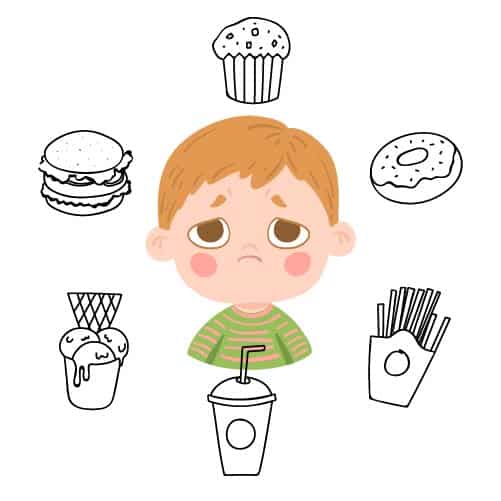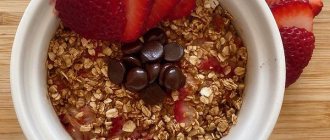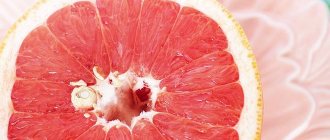Why is healthy eating important?
Everyone knows that children need to be fed healthy and nutritious food, but it is not so easy. There are a number of obstacles that have to be faced:
- From the first feeding, the baby tries to make his own taste preferences the basis of his nutrition. This can develop into a refusal of any innovations - as a result, he has a monotonous menu, and then it’s not far from improper eating behavior at school.
- Television advertising, the example of other children and lack of parental attention lead to the fact that a child in preschool age acquires bad eating habits, preferring “dry food” and sweets to healthy food.
- Then food becomes a field of struggle between parents and children, this makes family relationships tense, undermines mutual trust, harms health, but does not lead to the creation of traditions of proper nutrition.
This is why you need to instill healthy eating habits in your children (and yourself, if we're being honest!). And if you want your child to eat the right foods correctly, you need to teach him to do so from early childhood.
Rule #3. Inclusion of animal and plant products.
A teenager's diet should be varied and include products of animal and plant origin. It is useful to give a teenager vinaigrette, radishes, radishes with sour cream or vegetable oil, tomatoes, fresh cucumbers, green onions with sour cream or herring before meals.
Vegetables stimulate the appetite, promote the secretion of digestive juices and improve digestion.
How to eat right
These tips are universal for both adults and children:
- Small meals 5-6 times a day, with breaks of no more than 4 hours. The last meal is 2 - 3 hours before bedtime.
- 3 main meals are recommended: breakfast, lunch and dinner - and 2 snacks. Breakfast should account for 15 - 25% of the caloric intake of the diet, lunch - 30 - 40%, dinner - 30%. Snacking can account for about 10% of your daily calories.
- Preference is given to natural products with high nutritional value and freshly prepared dishes.
- A varied, balanced diet.
- A menu that takes into account seasonality and area of residence.
- The ratio of proteins, fats and carbohydrates in the diet (for a healthy body) is 15:30:55. It is better to eat protein foods for breakfast and lunch, carbohydrates (mainly vegetables) in the evening.
- It is recommended not to overuse salt and sugar, foods with preservatives, dyes, flavor enhancers, fried and spicy foods - all of this may be present in the diet, but in limited quantities.
- The preferred methods of cooking are boiling, steaming, baking in the oven and grilling, frying without oil.
- The calorie content of the daily diet should be equal to or slightly less than the energy consumed during the day. The approximate daily calorie intake for a healthy person depends on age and gender: for a child from 1 to 2 years old - 1200 kcal, from 2 to 3 - 1400 kcal, up to 1800 - for a child 3 - 7 years old, 2300 - 2500 - for teenagers 11 – 14 years old, 2500 – 2900 – aged 14 to 18 years.
- It is important not to forget about maintaining water balance. Children from 1 to 3 years old are recommended to consume 1100-1200 ml of liquid per day, from 4 to 8 years old - 1600 ml, from 9 to 13 years old - 1900-2100 ml, and adolescents 14-18 years old - 2000-2500 ml. In this case, all liquid entering the body is taken into account: soup, tea, juices, etc.
How should parents behave in order to instill in their child the right eating habits, form and timely regulate eating behavior in general?
Example of a daily menu

The information received will allow you to intelligently think through the diet for your child, but you can use a ready-made example
An example of a balanced diet for a 3-year-old child
At 3 years old, the range of products allowed for a child expands. The daily calorie content of dishes is no more than 1800 kcal. At this time, the most preferable is a four-meal diet*, in which 25% of the energy value comes from breakfast, 35% from lunch, 15% from afternoon snack and 25% from dinner.
Breakfast
A small fruit, 150-170 g of porridge.
Dinner
About 200 g of low-fat soup, a slice of bread.
Steamed poultry cutlet, 150 g of mashed potatoes and cucumber/tomato - to taste.
Afternoon snack
A bun, ice cream, or your child's favorite treat (in moderation!).
Dinner
Two egg omelette with cheese.
*each meal is accompanied by a drink in the amount of 200-250 ml.
Balanced nutrition for schoolchildren -
At an older age, children switch to five meals a day - this is convenient in connection with the daily routine and is enough for full life.
Breakfast
Cheesecakes with jam – 2 pcs.
Lunch
Big apple, banana or sandwich.
Dinner
Noodle soup – 200g, bread.
Baked fish with rice – 100/150 g.
Snack
Cookies – 70 g, orange.
First taste experience
When should you teach your child proper eating behavior? General advice - the sooner the better. Scientists conducted a study in which they observed the eating habits of 1,500 children from birth to age 6 years. It turned out that children who ate few vegetables and fruits before the age of 1 year refused to eat them even at 6 years old.
According to scientists, the best age to introduce children to healthy eating is 11–12 months. Moreover, breastfed children are more willing to try new foods.
A child gets acquainted with tastes even before birth: he acquires the first such experience in his mother’s stomach, when he swallows amniotic fluid, the taste of which depends on her nutrition. Then, receiving mother's milk, the child also experiences the tastes of mother's nutrition. Perhaps this explains the easier adaptation of such children to various foods introduced with complementary foods than in formula-fed children who receive formulas with a stable composition and uniform taste.
Empirically, it has been proven that a child’s perception of new foods differs depending on whether they were present in the mother’s diet during pregnancy and lactation. Take care of your own rational diet at these stages: it is this that has the leading influence on the adequate formation of the baby’s taste.
Some taste preferences are noticeable already in the first months of a baby’s life: he may, for example, favor sweet and salty tastes and reject bitter and sour ones. To some extent, this is a protective function of the body - to avoid foods that may contain poisonous and toxic substances, because they have a bitter taste (however, not all bitter foods are toxic - think grapefruit or persimmon).
Modern approaches to rational nutrition of young children
The modern theory of rational nutrition for children requires adherence to the following principles: 1) the supply of sufficient amounts of nutrients to meet the child’s needs for energy and basic components (proteins, fats, carbohydrates, minerals and trace elements, vitamins); 2) the principle of balanced multi-component nutrition; 3) compliance of the quantity and quality of food with the physiological capabilities of the child; 4) prevention of nutritional imbalances by advancing the intake of nutrients; 5) the principle of the indispensability of breastfeeding in the early stages of child development. The correct ratio of all components of the diet, timely changes in accordance with the changing physiological needs of the baby are the basis of their proper nutrition and, because of this, should serve as the object of the closest attention of pediatricians. The most optimal and natural type of nutrition for children 1 year of life is breast milk, which is considered as the “gold standard” of physiologically adequate nutrition. Mother's milk is a unique, optimally balanced food product that meets the individual needs of the child. Moreover, the composition of nutrients in human milk changes throughout lactation, adapting to the child’s changing needs during growth. In addition to nutrients, human milk contains a large number of biologically active substances and protective factors (taurine, polynucleotides, hormones, immunoglobulins, growth factors, macrophages, etc.) that affect growth, development, immunological resistance, intellectual and neuropsychic development. In addition, breastfeeding creates a close psycho-emotional connection between mother and child [3,4,5]. Despite the fact that the question of the benefits of natural feeding does not raise any doubts, unfortunately, the prevalence of breastfeeding remains low, ranging from 30 to 50% among children by 3 months of age (according to different regions). The main reason for this situation is the lack of dominant breastfeeding among women. The second reason is the incorrect attitude towards breastfeeding by doctors and other health workers, who should take the most active position in supporting breastfeeding. Human milk with an optimally balanced chemical composition of ingredients has become the standard for calculating the nutritional needs of a child in the first year of life. In Russia, standards for the requirements for nutrients and energy have been adopted, approved by the Ministry of Health of the Russian Federation in 1991. They include the requirements for proteins, fats, carbohydrates, energy per 1 kg of body weight and the requirements for 3 minerals, 3 microelements and 10 vitamins per 1 kg of body weight. for a day. The ratio between proteins, fats, and carbohydrates changes throughout the first year of life, reflecting an increasing need for proteins and a decreasing need for fats. If the mother is malnourished, the amount of protein, fat, vitamins, minerals and trace elements in breast milk may be reduced. The composition of breast milk can be improved by adjusting maternal nutrition. Breastfeeding women may be advised to include special foods in their diet that increase lactation; they can use juices, fruit and vegetable purees labeled “Baby” or “Dietary” food (for example, “FrutoNyanya”). All these products are enriched with vitamins, minerals, microelements and are easy to use. The food of a nursing mother should be tasty and varied. It should be remembered that foods such as beets, cucumbers, grapes, prunes, melon, etc., consumed by the mother, can cause functional disorders in the child’s gastrointestinal tract, especially in children in the first months of life. Previously, it was accepted that children should eat strictly by the hour, observing first a 3- and then a 3.5-hour break with a double night interval between feedings. Currently, the greater effectiveness of “free” feeding is recognized, which is understood as applying to the breast as many times as the child requires. Free feeding has a positive effect on the mother's lactation function, the health and physical development of the child. However, in some cases, if the mother does not understand the reasons for the child’s anxiety and attempts to eliminate it by frequent breastfeeding, overfeeding may occur, which can lead to excess body weight and the occurrence of gastrointestinal dysfunction. Therefore, one of the important tasks of the local pediatrician is to jointly analyze with the mother the causes of the child’s anxiety. As the child grows, there is a need to use additional products, such as juices, various types of purees (vegetables, meat, etc.), cottage cheese, yolk, cereals, as well as milk and kefir. The gradual expansion of the child’s diet and the addition of mother’s milk (or its substitutes) with complementary feeding products and dishes is due to: 1) the need to replenish the deficit of energy and a number of nutrients in the growing body; 2) the feasibility of expanding the range of nutrients necessary for the further growth and development of the child; 3) the need to accustom the child to new types of food and master the skills of consuming thick and then dense foods; 4) the need for further development and training of the digestive system. The variety of nutrients included in complementary foods provides the full range of essential nutrients. With the introduction of complementary foods, the child’s “nutritional education” begins. When introducing new complementary foods, symptoms of food intolerance may occur. The main clinical manifestations are expressed in a violation of the functional state of the digestive tract (regurgitation, vomiting, flatulence, intestinal colic, unstable stool), and the appearance of allergic skin reactions. The first foreign products that a child of the first year of life is introduced to are first fruit juice, and then fruit puree. They are introduced earlier than main complementary foods. The choice of fruit juice is due to its ease of absorption and liquid consistency. It is recommended to start introducing juice from 3–3.5 months. Earlier introduction of juices is not advisable, as this can provoke the appearance of dysbiotic disorders and allergic reactions [21,23]. In the range of juices recommended for children in the first year of life, specialized juices for industrially produced baby food (FrutoNyanya, etc.) are more appropriate. This is due to the fact that in the current conditions only industrially produced products can provide a guarantee of quality. Apple juice is usually the first choice. It is better to use green apples. They begin to give juice with a few drops, gradually increasing it to 20–30 ml over 5–7 days. It should be especially emphasized that the introduction of juices should begin with the juices of one type of fruit in order to exclude its possible allergic effect. Only after getting used to it can juices from various fruits be introduced into the diet [18,21–23] (Table 1). The daily amount of juices can be calculated using the formula n x 10, where n is the number of months of the child’s life. Thus, by 10–12 months the amount of juice per day reaches 100 ml. The volume of juices is not included in the daily nutritional intake. 2-3 weeks after the child gets used to apple juice and is well tolerated at the end of the 4th month of life, denser foods can be introduced into the diet - fruit purees, using the same assortment of fruits as for juices, and the same sequence of introduction. From 4.5–5.5 months, thicker food or “complementary feeding” itself can be introduced into the child’s diet. As the first main complementary food, you can use either vegetable puree or milk porridge, but vegetable puree is better, since the child needs mineral salts, organic acids, plant fibers, etc. But if the child is not gaining weight well, has unstable stool, it is more advisable to start introduction of complementary foods with milk porridge. The introduction of vegetable complementary foods should begin with one type of vegetables (potatoes, zucchini), then moving on to a mixture of vegetables with a gradual expansion of the assortment and the introduction of cauliflower, carrots, and later tomatoes and green peas into the diet [18,21]. From 8 months you can add onions in small quantities. From 9 months you can add spicy herbs (dill, parsley, celery). Begin administration with 1–2 teaspoons and gradually increase to the desired volume over 1–2 weeks. Another 1–2 weeks are spent on complete adaptation and expansion of the range of vegetables. Thus, the introduction of complementary foods takes 3–4 weeks. A month after the introduction of the first complementary foods, milk porridge is introduced - the second type of complementary foods. For porridge, it is initially better to use gluten-free grains - rice, buckwheat, corn, since gluten-containing grains (wheat, oats) can cause the development of celiac enteropathy in young children. It is recommended to introduce the most easily digestible rice porridge first, then buckwheat, corn, then oatmeal and, lastly (not earlier than 8–9 months) semolina. It is most convenient to use commercially produced instant (instant) milk porridges for children in the first year of life. They are enriched with a complex of vitamins and mineral salts, including iron, which is necessary for a child in the 2nd half of life. Thus, 2 months after the start of the introduction of the main types of complementary foods, that is, by 7–8 months, you can completely replace 2 breastfeedings by the mother, replacing one of them with milk porridge with the addition of fruit puree (for example, rice milk porridge with pumpkin and apricot “FrutoNyanya” "), and the second - vegetable puree. At the request of the mother, to maintain lactation, breastfeeding can be recommended after taking complementary foods. Previously, consumers had to, on the recommendation of doctors, prepare a mixture of porridge with fruit puree themselves. To date, the Lebedyansky holding has produced porridges with natural purees added industrially. Cottage cheese should be prescribed to healthy children over 5–6 months of age before breastfeeding. Start with 1/4–1/2 teaspoon. Gradually, the serving volume is increased and brought to 30 g, from 8 months - to 40 g, and from 10 - to 50 g per day. From 6–7 months, the yolk of a hard-boiled chicken egg is introduced into the child’s diet. In the absence of allergic reactions, the amount of yolk is first adjusted to 1/4, and from 7–8 months to 1/2 yolk per day, adding to porridge or vegetable puree. It is not recommended to exceed this volume in the 1st year of life. The yolk is given 3-4 times a week. From 7 months, meat should be introduced into the baby’s diet. If necessary (in children with anemia, rickets, malnutrition), meat can be introduced earlier - from 6 and even from 5–5.5 months, given the availability of canned baby food that is well homogenized. The introduction of meat begins, as a rule, with lean beef. Start with a teaspoon and gradually increase the volume, first to 30 g (1–1.5 tbsp.), from 8 months – to 40–50 g (2–2.5 tbsp.), and from 10–12 months - up to 60–70 g (3–3.5 tbsp.). You can also use chicken, turkey, rabbit, and lean pork. By 10 months, meat puree can be replaced with meatballs, and by 1 year - with meat soufflé, steamed cutlets, and meatballs. It is better to give meat puree together with vegetable puree. It is preferable to use specialized commercially produced meat purees for baby food. From 8–9 months, the range of complementary foods can be supplemented with fish. Fish can cause allergic reactions, so it is administered with extreme caution in the form of boiled fish puree, starting with 1/2 teaspoon, observing the child’s reaction, increasing the volume to 50–60 g by 10 months. Fish is given 1-2 times a week instead of meat puree. Low-fat varieties of fish are recommended: cod, flounder, pike perch, hake, pollock, etc. The food of an infant should be lightly salted, since due to the immaturity of the kidneys, sodium salts are easily retained in the body. Some canned vegetables and meat and vegetables are made without adding salt, while others are made with the addition of small amounts of salt. It is better if the child gets used to unsalted but healthy food from a very early age. The habit of eating salty foods from childhood can subsequently serve as one of the causes of hypertension and other diseases. Until recently, nutritionists recommended the use of kefir or whole cow's milk from 8–10 months. However, these positions have now been revised. Cow's milk and kefir, as unadapted dairy products, have disadvantages. These are, first of all, excessive osmotic load on the kidneys, excess protein content, predominance of saturated fatty acids, low content of many essential nutrients, and high allergenicity. Instead of cow's milk, adapted milk formulas based on cow's milk are recommended. Among the adapted fermented milk mixtures is “AGU-1”, fermented with bifidobacteria in combination with acidophilus bacillus (Lianozovsky baby food plant, Moscow). Fermented milk products not only serve as a source of many nutrients, but also have a number of other important physiological effects. Their probiotic effect should be put in first place here. This effect, combined with the ability of these products to stimulate the immune response of infants, as well as the bactericidal effect of lactic acid, underlies the protective effect of fermented milk formulas against intestinal infections [7,8]. As for the stimulating effect of these products on the immune response, its mechanism obviously includes the activation of the production of some regulators of the immune response of enterocytes: phagocytosis and proliferation of lymphocytes. Along with the probiotic and anti-infective effects, fermented milk products have a beneficial effect on intestinal motility, which can be used to normalize its function [8]. The article discusses aspects of only natural feeding. The proposed recommendations for feeding children in the first year of life are based on the results of an analysis of modern literature. Their validity has also been confirmed by clinical experience in monitoring children in the first year of life. However, this does not exclude the need for a broad discussion of proposed approaches to the organization of nutrition for young children and its improvement, taking into account new achievements in pediatrics and child nutrition.
References 1. Present knowledge in nutrition, Zieger E., Filer L., Eds., Washington: ILSI Press, 1996, p. 660. 2. Nutrition of normal infants, Fomon S., Ed., Mosby, 1993, p. 420. 3. Vereshchagina T.G., Mikheeva I.G. Nutrition of children in the first year of life, Educational and methodological manual. – M., 2005. 4. Vorontsov I.M., Fateeva E.M., Khazenson L.B. Natural feeding. – St. Petersburg, 1993. p. 198. 5. Kon I.Ya., Gmoshinskaya M.V., Kopytko M.V., Vorobyova I.N. Attitudes of expectant mothers towards breastfeeding: test results. // Pediatrics, 1998, No. 5, p. 63–65. 6. Kon I.Ya., Sorvacheva T.N., Abramova E.I. Nutrition of children of the first year of life and morbidity in early preschool and school age. Mater. 5th Congress of Pediatricians of Russia “Healthy Child”, M., 1999. – p. 210. 7. Shenderov B.A. Medical microbial ecology and functional nutrition, M., 1998, p.285. 8. Kuvaeva I.B., Ladodo K.S. Microecological and immune disorders in children. M., “Medicine”, 1991, p.270. 9. Horse I.Ya. Modern principles of rational nutrition for healthy children in the first year of life, “Children's Doctor”, No. 5, 1999, pp. 40–46.
What influences food preferences
In addition to taste itself, the formation of a child’s food preferences is also influenced by:
- The smell of food;
- Its consistency;
- Compound;
- Appearance of dishes.
When introducing complementary foods when the baby begins to show interest in food, it is important not to make mistakes and take care of all the components of the product offered to the child:
- It should arouse interest with its design;
- Stimulate appetite by smell;
- The consistency and composition are appropriate for the baby’s age.
Agusha products meet all the requirements for baby food and not only help the baby develop correct eating behavior, but also attract him with interesting packaging.
It is worth noting that if a child categorically refuses food of a certain consistency (for example, with pieces), prefers food of the same color, or eats in unusual conditions (only in the dark or only on the floor), it is worth consulting with a specialist.
What to do if a child refuses certain foods? Naturally, he may not like foods or dishes that are still unknown and introduced into the baby’s diet for the first time. Is it too easy to accept your little gourmet's reluctance to accept this or that new dish? No, you need to patiently and repeatedly offer it to your child, sometimes masking it with your favorite dish. Patience and the parents’ own example, the family’s lifestyle as a whole can help overcome this problem.
Basic principles of baby nutrition

A short guide to the basics of proper nutrition for children and adolescents. Following these rules will help you easily teach your child to eat right and instill a love for healthy food.
The most important thing in a healthy diet is variety. Baby food should combine both animal products and plant products; both raw and cooked foods.
You can’t focus only on plant-based, dairy or low-fat products. A peculiar diet can disrupt the development of a child, contribute to excessive weight gain, develop vitamin deficiency or other abnormalities.
Children in any situation remain children, and food should correspond to this. This means that you should give up hot seasonings, sour sauces, exotic combinations or culinary delights; all additives should be as natural and mild in taste as possible, so as not to dull the sensitivity of the receptors. If a child refuses lunch, this does not mean that the food is tasteless. Before emptying the plate, the child evaluates it from an aesthetic point of view, namely, “Is the plate beautiful?”, “Does my food look attractive?”, “Does it smell appetizing?”, and only then tastes it. Young children need to be interested in food first, and only then offered to eat. You will have to fuss with the choice of dishes and serving food.
Don't forget that everyone has their own food needs and preferences. Some people need to eat 5 large portions of food, while others get by with two. These are all normal options; the most important thing is that food helps maintain normal well-being and maintain physical health. Already in childhood, the development of obesity or dystrophy should not be allowed.
The need for food changes with activity. One day, a preschooler may eat as much as an adult, and then completely refuse food for the entire next day. And this is also the norm.
On all walks you need to have enough water with you to be able to quench your thirst at any time. The child's body reacts very sharply to a lack of water, this is especially pronounced in hot weather or when playing sports. It is best to drink clean drinking water, but herbal teas without sugar, water with pieces of fruit or berries will also work. Do not replenish your water supply with store-bought juices, sodas or other sweet liquids.
Sweets - in moderation. Despite the fact that sweets are very often adored among children, you should not indulge in them: this is fraught with the development of caries, the appearance of excess weight, and impaired glucose absorption. It is important to remember that at the end of the day, honey, cane sugar or fructose is no different from regular white beet sugar. There is also a lot of glucose hidden in dairy products and baked goods.
Food rules
So, what are the rules that, if followed, will help instill in your child the necessary eating habits and ensure the healthiest diet possible?
- Shape your baby's eating habits during pregnancy. Healthy eating during pregnancy is the path to healthy eating after the baby is born. The way a pregnant woman eats also influences her baby's future eating habits. It is important to understand that “healthy” primarily means “balanced”, and a complete rejection of everything “tasty” is not meant here: a balanced diet can include all foods, but you should limit the intake of foods high in salt, sugar and saturated fat.
- Think over your menu during breastfeeding. Many people know that mother’s breast milk provides the baby’s immunity and reduces the risk of food allergies. But besides this, it gives mothers an additional opportunity to form correct eating habits in their baby. The baby can “get used to” the foods included in the mother’s diet already in infancy.
- Don't give up if your baby refuses to take the healthy foods you introduce. The best way to encourage your baby to eat healthy is to offer healthy foods on a regular basis. You shouldn’t give up if he refuses them over and over again - sometimes you just need to patiently offer them several times (5, 10, 15 times - on the 16th the baby gives up and starts eating). Your position should not be rigid, but persistent. It is important that you have patience, so clearly formulate for yourself what you want to teach your baby to do, strictly follow your rules and do not give up.
- Follow the diet. Try to organize the daily routine so that the baby has 4 to 6 meals a day in small portions (it’s better for the baby to ask for more than for the half-eaten half of the plate to go to the trash can), preferably at about the same time. This will help maintain blood sugar levels, protecting the brain from starvation.
- Eat in a specially designated and equipped place. Eat at a properly set table. Provide your child with his own individual set of dishes; If the baby is already old enough, he can choose his own plate, cup and cutlery in the store. This aspect should not be underestimated for one simple reason: this is how the baby understands that food is important, and in the future he treats this area of his life more responsibly and with attention.
- Maintain variety in your diet. Your daily diet should contain all the necessary vitamins and minerals. For health and good spirits, the body requires a sufficient amount of fluid, proteins, fats and carbohydrates, and microelements. But take care of the varied menu. Eating the same thing over and over can lead to a deficiency of essential vitamins, get bored and the baby will begin to refuse previously favorite foods.
- Calculate the portion size correctly. We are used to hearing from parents that there should be nothing left on the plate. However, much greater harm can be done to health if we eat when we are already full! We should give up the habit of finishing everything on our plate and not teach our children to do the same. An interesting system in this sense is the system of measuring food portions “by the palm of your hand”: the portion size is the food that “fits” in your hand.
- Eat together. At least once a day, combine your own meal with feeding your child - this way you will not only instill healthy eating habits in your child, but also help him learn table manners and observe other rituals associated with food.
- Surround food with positive emotions. A child should have exclusively positive emotions associated with food: eating is not only about saturating the body with useful substances, but also about pleasure. Don’t force your child to eat, give him as much food as he willingly eats, don’t rush, coax, or intimidate. If your child refuses a “tasteless” but healthy product, experiment with ways of preparing and serving it, but do not scold or punish your child for refusing. Continue to offer this product in different forms, without unnecessary pressure and with long pauses. In the end, your baby’s refusal of this or that food may be a signal of a hidden food intolerance, and if you insist on your way, you may not only not achieve any benefit, but also cause harm.
- Create rituals associated with eating. Warn in advance about meal times, teach to wash hands before and after meals, help adults with serving, sit upright at the table, eat carefully, use cutlery and napkins correctly, clear the table after eating, wash dishes - simple steps to create the right food culture. The child will more than once appreciate your efforts when he finds himself in a society where table manners are scrupulous.
- Eat food in a calm environment. While eating, you need to remove all toys from the child’s field of view, turn off the TV and eliminate other irritants. This way, the baby will be able to focus on the food itself, listen to signals of satiety, and enjoy the dish. Even conversations (except for reinforcing ones at the stage of introducing complementary foods) should be postponed to another, more appropriate time: when I eat, I am deaf and dumb!
- Choose products and prepare food together. The child will be happy to try something that he himself has put a lot of effort into creating. Prepare healthy food with him, tasty and imaginative, so that the baby understands that “healthy” does not mean “tasteless.” Master new recipes with your child, let him also show his imagination.
- Make sure you have healthy snacks between meals. Small snacks can serve as second breakfasts and afternoon snacks. Fresh fruits and vegetables, cheese, grain breads, nuts, dried fruits - try to keep these snacks in your home and always available to your child.
- Prepare healthy analogues of your favorite industrial “delicacies” yourself. However, sometimes you can indulge in industrially produced “delicacies”! In addition, you can cook almost everything at home: potato chips or other root vegetables, chocolate, marmalade, jelly, ice cream, caramel. Candies can be replaced with fruits, yoghurts, nuts and dried fruits, chocolate bars with dark chocolate, ice cream with homemade berry sorbet.
- Be sure to praise. It has already been proven more than once that praise works much better than punishment and positive reinforcement gives a much stronger result. Praise your child when he chooses the right foods, encourage him if he cleans up after himself from the table, tries to eat carefully and does not spill, when he finishes eating, follows the rules, and sits calmly at the table. There are many reasons for praise; don’t miss the chance and please your child with your approval.
- Do not manipulate with food. Food should not be a comfort, reward or punishment. Also review your eating habits. Even a very small child notices everything: if you constantly eat candy, then he will definitely want to try it, and you will not be able to explain to him that it is harmful.
- Be attentive to the clues your baby sends you. Try to follow the principles of intuitive eating. You may not even notice that your baby “on his own”, easily and without coercion, chose healthy foods as the basis of his diet: after all, he is just following the natural needs of his growing body.
- Avoid looking at a screen while eating. It has been scientifically proven that this way you eat much more food than necessary. And if the TV is constantly on in the house, the child becomes not only dependent on the screen, but also a victim of advertising, to which young children are very susceptible, so dose the incoming information.
- Personal example. Until now, psychologists and teachers have not found anything that would work better than personal example. It is very important to have family feasts, when the child will watch how dad eats and what mom does at the table. Of course, when both parents work and the child is in kindergarten, it is difficult to organize this, but it is still possible. Let it be at least joint breakfasts or dinners, or maybe just weekend feasts.
- The whole family should adhere to the same rules. Try to agree with all family members (even those who live separately, but with whom your child regularly sees) about common approaches to the principles of healthy eating and food culture. Similarly, the prohibition on regular absences from the table during mealtimes to watch the TV or for other “important matters that cannot be urgent” should be supported by all family members caring for the child’s upbringing.
- Family dinners. In many families, it is no longer customary to have family dinners, when everyone gathers around a large set table, discusses the events of the day, plans for the future, and expresses emotional support to each other. With the modern pace of life, a warm family dinner at the end of the working day is sometimes the only opportunity for a family to unite again, recharge with energy and tune in for the next day. Keep this tradition and pass it on to your children: the family gathered at dinner is our support and support, our safe haven.
Additives that negatively affect the body

The child's body is highly susceptible to the negative effects of various food additives. Children suffer from food allergies more often than adults. A lot has already been said about allergies to chocolate and citrus fruits, but what substances in seemingly harmless food can negatively affect your health?
Preservatives
Their action is based on the fact that all living organisms die in the environment created by these substances, thereby extending the shelf life. Of course, people do not die from preservatives like bacteria, however, this is the most obvious example. The mass of a person is much larger than that of a single cell, so rare consumption of food with preservatives will not cause irreparable harm, but these additives are by no means safe.
Dyes
Every year, more and more dyes are prohibited from being eaten, since it has been scientifically proven that some of them cause allergies, metabolic disorders, negatively affect the liver and even cause the development of malignant neoplasms (oncological tumors). Artificial (synthetic) dyes make food brighter and more appetizing, but their effect on the body is too negative to be given to children.
Sodium benzoate
Sodium benzoate, or E211, is an additive that is used in soda, sauces, and chips. Excessive consumption of this benzoic acid salt is fraught with allergies, and in the worst cases, cancer.
Aspartame
Aspartame, or E951, is the most common sweetener due to its low cost, which is used in “0 kcal” sodas and so on. It has no energy value, but it tastes very sweet, which is why it is often used as a substitute for sugar by those losing weight. But not everyone knows that it disrupts metabolism and brain activity and leads to allergies.
Monosodium glutamate
Monosodium glutamate, or E621, is widely used in fast food. The danger of consuming monosodium glutamate is that it disrupts the activity of the liver and kidneys, reduces concentration, and in certain cases, due to individual intolerance, provokes serious food poisoning.
Should children be forced to eat?
How can you convince your child to eat healthy food if he refuses? There is a huge gap between persuasion and compulsion to eat. When a mother convinces, she is not offended by the child’s refusal and does not demand that he continue eating.
“Until you eat everything, you won’t leave the table”—familiar words? It is clear that our grandmothers simply had no choice, but there is no point in continuing this tradition of food tyranny.
Yes, it’s a shame when a lovingly prepared dinner remains on the plate practically untouched. It seems that the child neglects our care - all the effort that was spent on obtaining food and preparing it. And as if overcome by spirits from a distant Soviet childhood, we furiously repeat the words of our grandmother: “So many people are starving, and you! Mom and dad are trying, working, but you are wandering around! If you don’t eat, you’ll remain small and weak!”
But think better about the fact that such words are dictated not by care, but by a selfish feeling of resentment for the fact that our love and care were rejected.
According to many studies, there is a connection between a child's upbringing and eating disorders in his adult life. Parents around the world behave in similar ways, but justify food pressure differently.
In the West, adults are guided by the fact that it is “tasty”, “healthy”, “expensive” and “should be eaten fresh”, and in countries such as Mauritania, a mother will be ashamed of her skinny child, since all the neighbors their family will be considered poor. This is especially true for girls, who in Arab villages are still fattened up to the standards of the 1001 Nights fairy tales, according to which a woman’s navel should “hold an ounce of peanut butter.”
The harmful consequences of forced eating: food as comfort.
But eventually, obedient children stop eating because they are hungry and begin to use food for other purposes. The food eaten turns out to be a way to earn mom's praise and thus experience pleasure. And in their adult lives, they will also turn to food to comfort themselves when they are stressed or sad.
Unfortunately, too much control on the part of parents regarding nutrition very often leads to similar results. The same applies to prohibitions on harmful products: the child stops perceiving them as food and sees in them only an inaccessible pleasure. When we force a baby to eat a healthy product, which he persistently refuses, he again ceases to perceive it as food. For him, this forever remains a lost battle, in which he was defeated by a stronger opponent.
72% of people who were forced to eat specific healthy foods as children eliminated them completely from their diets as adults.
What is intuitive eating
The concept of “intuitive eating” counters the idea of being forced to eat. It is based on the ability to listen to your body, trust it and proceed from the true needs of your body, and not from average recommendations. There are different ways to approach this technique, but intuitive eating in response to signals coming from the body truly harmonizes our relationship with food.
And most importantly, a person remembers that he can be attentive to his feelings, emotions, needs and rely on them in his choice.
- It doesn't take much effort to follow these approaches. Especially when we are talking about little gourmets. After all, children, whose bodies are not yet familiar with an unbalanced menu, stress, and unhealthy habits, know when, in what quantities and what kind of food they need to feel good, and often give us, adults, hints with their behavior. Unfortunately, we often turn a deaf ear to them, even when driven by the best intentions: to feed generally accepted healthy food... and more of it!
- The best thing parents who are wondering how much average standards and indicators should govern their children's lives can do is to abandon stereotypes. It is very important not to drown out the baby’s natural wisdom by insisting on your adult, “correct” ideas about healthy eating patterns.
- But if your baby prefers kefir every day, meat no more than once a week, and always refuses milk altogether, trust him: in addition to the fact that he intuitively corrects some imbalance in the body (perhaps right now he lacks bifidobacteria), he also wants to teach you something very important and well forgotten by you - the ability to trust yourself.
The eating habits that a person develops from childhood will remain with him throughout his life, and then he will teach his children to eat the same way. That is why it is so important right now, while the child is small and eats mainly what we prepare and offer, to establish the right habits that will help maintain his health. Discipline yourself, follow the principles of healthy eating and lifestyle, and pass them on to your children. Health to you and your families!
Article on our Yandex.Zen channel
What substances are needed by a growing body?
Without a sufficient amount of nutrients, proper nutrition of a child is impossible. The child's body needs all the vitamins and minerals, such as:
- Vitamin A (retinol) - for vision, “growth vitamin”;
- B vitamins - to support physical and psychological health;
- Vitamin C, or ascorbic acid, is the main antioxidant in the human body;
- Vitamin D ensures normal growth and development of bones;
- Vitamin E - for tissue regeneration, improves blood circulation and clotting;
- Vitamin H (better known as biotin) improves skin and hair condition;
- Vitamin K affects blood clotting; its deficiency is a very rare occurrence;
- Vitamin PP regulates redox processes in the body;
- Sodium regulates cardiac function;
- Potassium is involved in metabolism, helps conduct impulses and nerve contractions;
- Magnesium - for phosphorus metabolism; in older age it is necessary to lower blood pressure;
- Phosphorus - energy metabolism, one of the main components of bone tissue;
- Calcium is an essential micronutrient for bone health. Vitamin D helps calcium to be absorbed. This substance is extremely important for the proper formation and strengthening of the skeleton;
- Zinc - strengthens immunity;
- Iron - for blood health, an important component of hemoglobin;
- Copper - hematopoiesis;
- Manganese activates the action of enzymes;
- Molybdenum - against the development of caries;
- Cobalt - participates in the metabolism of fatty acids;
- Chromium is essential for maintaining healthy blood sugar levels;
- Selenium - antioxidant, cancer prevention;
- Iodine is needed for the functioning of the thyroid gland;
- Silicon gives elasticity to skin and hair;
- Vanadium prevents the development of caries in children;
- Sulfur increases the body's resistance to toxins;
There is no need to calculate the exact need for a particular substance for a child, since if you follow the rules of proper nutrition for children, they will involuntarily be supplied in sufficient quantities.
Special attention should be paid to fish oil, since many modern parents have heard about it since childhood. Is it really that useful? Should you give it to your child? Fish oil is famous for its large supply of fatty acids and vitamins A and D; it strengthens blood vessels, improves brain function, promotes attention and concentration, and has a positive effect on vision and calcium absorption. However, fish oil as a dietary supplement is not recommended for infants, and its use is useless if the child eats enough fish, likes salmon, tuna, mackerel, and so on.











